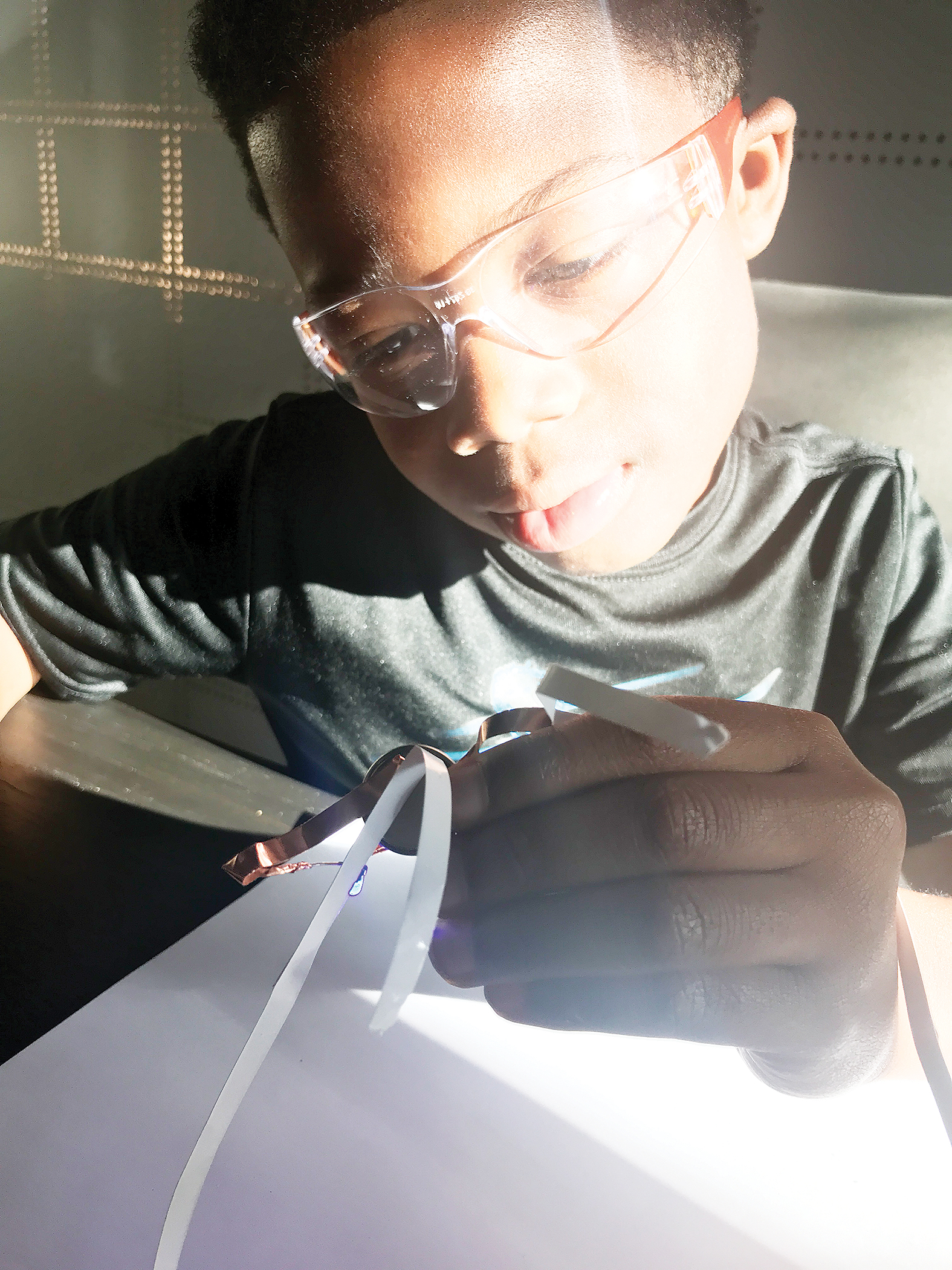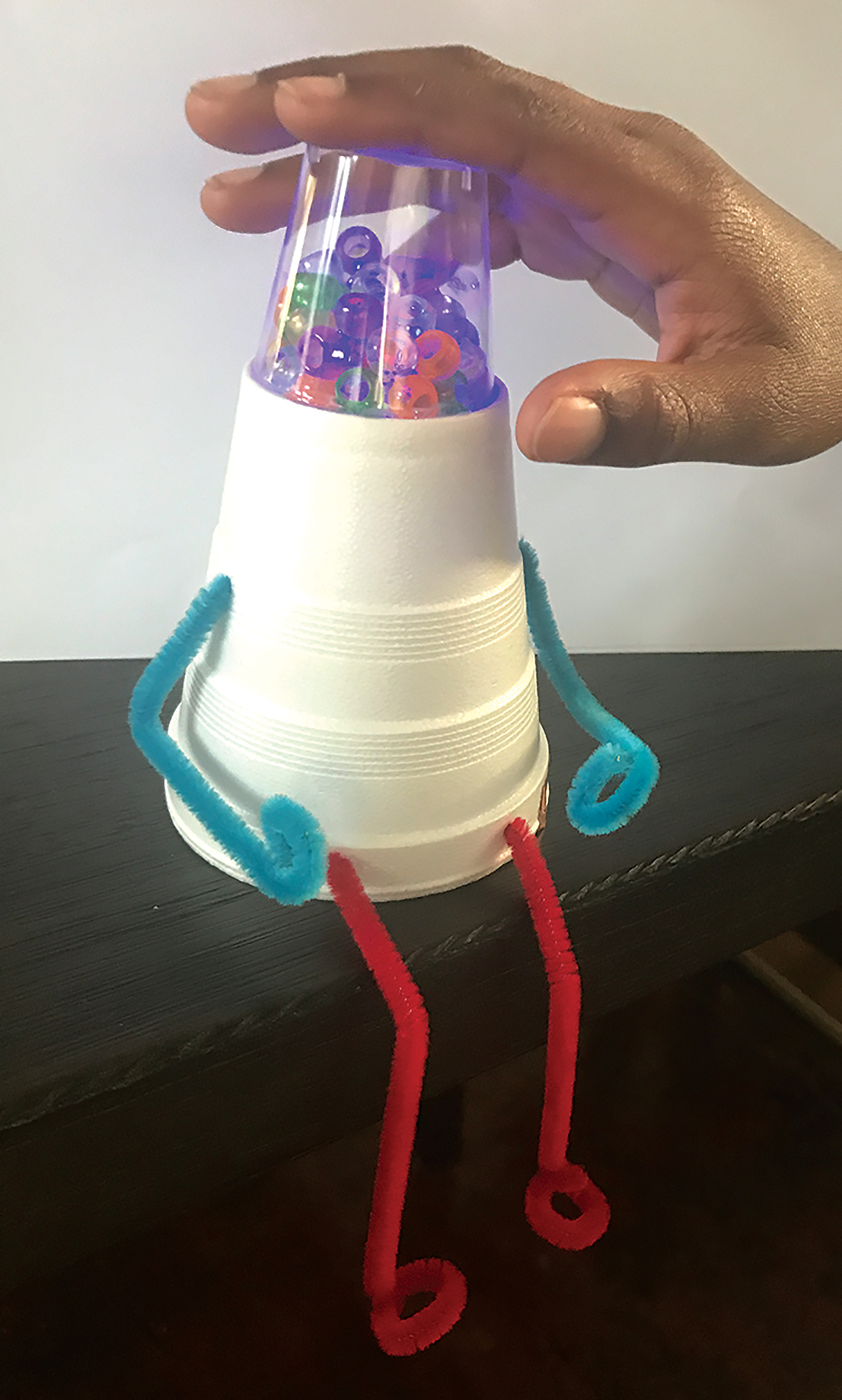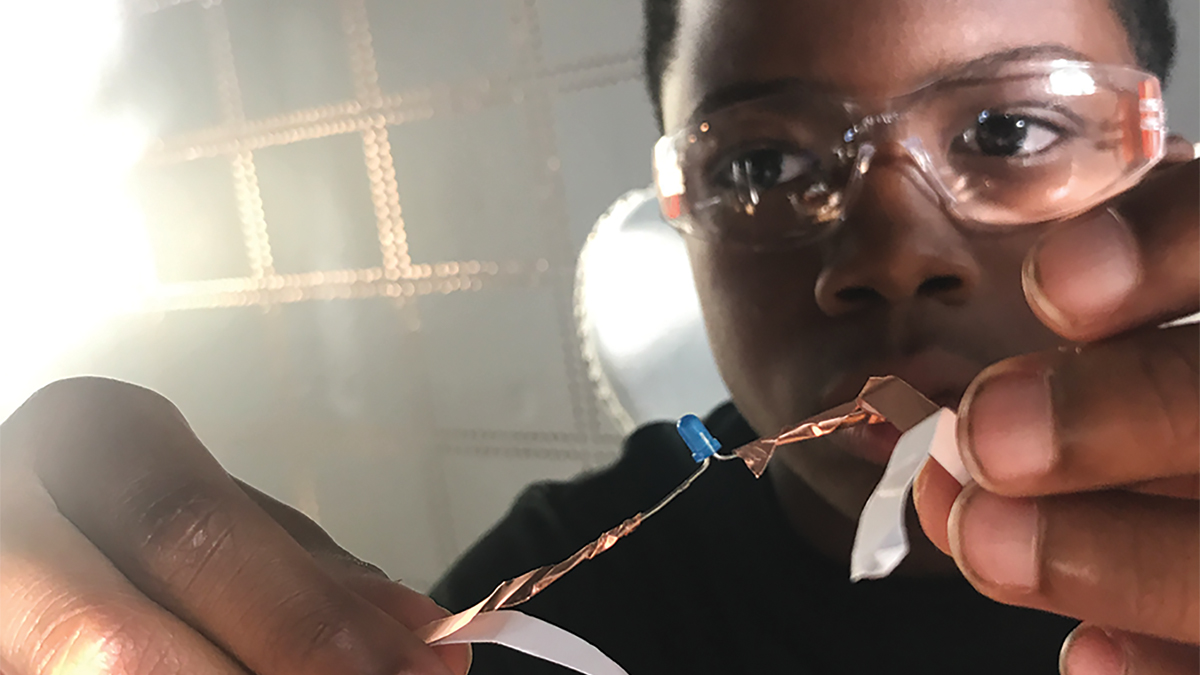Robots and Reading
Trade books and circuit activities enhance science literacy and energy education.
Electricity is an integral part of our daily life. We interact with and notice the effects of electrical connections and disconnections daily. Children, like adults, infer the effects of electrical conductivity. They see the illumination of a lightbulb or feel the emission of warmth from an electric stovetop but may not understand the role electrical circuits play. Focusing on the concrete aspects of electrical energy transfer helps improve student experiences with the abstract concept of electricity. In this article we provide experiences for elementary-age children to explore electrical circuits. Our purposes for these lessons are for students to develop questions and connect their exploration of electrical energy to concrete observations of electrical effects found in trade books. While portions of the described lesson is aligned to Next Generation Science Standards (NGSS) performance expectation 4-PS3-2 Energy, emphasis occurs on the design expectation 4-PS3-4 Energy.
As STEM content and practices become increasingly integrated in other subjects, children are likely to see examples of effects of electricity without understanding it. Children never see energy traveling through conducting material. They only hear, see, or feel the results of energy movement. For example, in Christina Geist’s (2016) Buddy’s Bedtime Battery, the main character, Buddy, mimics robots as rigidly moving and beeping apparatuses. Other books such as Pete the Cat: Robo-Pete by James Dean (2015), Boy and Bot by Ame Dyckman (2012), and Rusty the Squeaky Robot by Neil Clark (2019) portray robots as masses of metal that comply with human commands. Knowledge of simple circuits is not a prominent component of these stories; there is only a portrayal of complete circuits or the results of completing a circuit. Providing opportunity for children to experience and experiment with complete and incomplete simple circuits provides an introduction to the complex topic of electricity.
In this lesson, we highlight connections between the Common Core State Standards (CCSS) and grade 4 energy performance expectations from the NGSS. August et al. (2014) writes that both sets of standards rely on the development of academic language. The CCSS and the NGSS have been designed to enable students to meet the rigorous academic demands of all subjects (Lee 2017) and the language in the CCSS highlights links between subject-specific knowledge and literacy (Cervetti and Hiebert 2015). Additionally, many of the learning descriptions and active verbs in both the NGSS and the Common Core show commonalities, such as analyze, interpret, observe, notice, ask, answer, draw, dictate, write, and describe (Clark and Lott 2017).
In elementary school classrooms, curricula that highlight these connections often utilize discipline-based literacy. Integrating children’s literature can help make science concepts more relatable by providing context to help children build connections between science and their lives (Barclay, Benelli, and Schoon 2012). This integration of the NGSS and the CCSS shows that “writing and reading can be used as tools to support inquiry-based science,” and that “reading and writing benefit when embedded in an inquiry-based science setting” (Pearson, Moje, and Greenleaf 2010, p. 459).
The upcoming activities are thematically linked to form a 5E lesson suitable for concepts found in grade 4 NGSS. The first three activities—Engage, Explore, and Explain —are included but minimally described, as they are common electricity activities. The Elaborate and Evaluate activities are the foci of the lesson and provide opportunities for children to build their own circuits and write stories that connect their creations to a selected text.
Safety First
Before beginning the engage component of the lesson, provide each student with side shield safety glasses or goggles to protect their eyes from the potential of flying sharps. In lieu of wire cutters or nippers, school scissors should be used to cut any thin wires often found in small inexpensive flashlights. Provide each group with two pairs of scissors.
Due to the size of CR2032 batteries, remind students to never place them in their mouth. To reduce overheating of wire and lighted LED bulb, do not keep the circuit active for long periods. Instruct students to let their teacher know immediately if an LED bulb breaks/shatters and do not touch the bulb (immediately clean up any broken bulbs by sweeping them up while wearing gloves and disposing of them as hazardous waste).
Engage
For the Engage phase, students interact with and dismantle a flashlight. Begin the activity by creating groups of mixed- ability students with three to four kids per group. Post and mention the following question and statements, “What do you notice about the flashlight? Interact with it; take it apart. Write and draw what you observe.” Provide one flashlight per group. Encourage students to turn the flashlight on and off and dissect the flashlight by removing portions of its inner components. After being advised to draw, label, and record observations of the flashlight in their science journals, require students to display and present their drawings and observations about the components of a flashlight.
Student presentations confirm the results of a complete flashlight circuit. They will typically draw light emitted from the flashlight and some may indicate a warm lightbulb. Teachers interpret these drawings as a student’s ability to indicate the results of the simple flashlight circuit instead of an explanation of how the light and warmth are created. These observations create the foundation for identifying how simple circuits work. Additionally, such observations are easily confirmed in fictional texts that can be integrated into the lesson during the explore phase.
Explore
In the Explore activity, provide students with fictional texts that have a robot theme. Examples include Buddy’s Bedtime Battery (Geist 2016) or Pete the Cat: Robo-Pete (Dean 2015), Boy and Bot (Dyckman 2012), or Rusty the Squeaky Robot (Clark 2019). Encourage students to read their selected text and identify portrayals of circuits by considering the guiding questions, “Which parts of circuits are present? How are circuits illustrated?" and "What evidence of complete circuits are illustrated?” Ask students to list questions about circuits, robots, and flashlights. For example, after students read Pete the Cat: Robo-Pete, students identified illustrations of flashing lights, batteries, sounds, and motion as the author’s evidence of a complete circuit. Their questions were, “What is the source of Robo-Pete’s energy? How is the battery connected to the robot? How does the switch work? Where are Robo-Pete’s wires? How does Robo-Pete move?” Require students to contrast what they notice in textual drawings with what they experienced during the flashlight dissection—ask students to identify the components of the flashlight that are omitted from their selected texts. For instance, Dean illustrates a battery for Robo-Pete, along with a switch, a robot voice, and skateboard motion; however, wires and complete circuits are completely omitted from the illustrations. Students noticed these omissions when they compared their drawings with the text illustrations. Lead students to realize that authors claim complete circuits in fictional texts by presenting illustrated evidence (e.g., colorful lights, turning wheels, and robot dialogue). Coincidentally, such omissions can create misconceptions, as the reader never sees the required circuits or components. Use the explain phase to shift student attention toward the presence of components within and required configuration of a circuit.
Explain
Student-generated questions, dissected flashlights, and labeled drawings are key components for the explain portion of the lesson. Facilitate a class discussion to foster connections between student experiences in the engage and explore sections (Owens 2015). Elicit student questions and observations to create conceptual connections by asking the following guiding questions: What questions do you have after reading the text? (Answers vary) What are your observations about the flashlight when it is on? and off? (Answers vary) What is the energy source of the flashlight? (Battery) How do we know energy is present? (The light is on, or I feel heat.) How do we know the energy has stopped moving? (The light is off, or the bulb is cool.) When can the battery provide energy to the lightbulb? (When the bulb is correctly connected to both ends of the battery) What connects the battery to the lightbulb? (Wires or metal) How does energy in the flashlight move? (Energy travels through or down the wires.)
Connect student drawings to explanations about circuit requirements. Display simple circuit diagrams from a web simulation like the PhET Interactive Circuit Simulator website (see Internet Resources). Encourage students to build and review details about complete and incomplete circuits by using the diagrams as models to rebuild the flashlight circuit. Illustrate that circuits must contain pathways that are conductors, materials that energy moves through, and an energy source such as a battery. Mention that an indicator, like a lightbulb, motor, or alarm, displays energy transfer processes such as light and heat, motion, or sound (Duncan, Krajcik, and Rivet 2017). State that complete circuits allow the energy to move through the pathway and indicator. Additionally, when diagramed, complete circuits make a circle or continuous pathway. End with the statement that incomplete circuits do not allow energy to move through the pathway and indicator.
Elaborate
After students confirm needed components and configurations for simple circuits, return to incorporating trade books with similar themes to provide additional context for the science lesson. For instance, Buddy’s Bedtime Battery provides an opportunity for teachers to invite students to build the main character, Buddy, a companion robot. In the story, Buddy, a toddler, acts like a robot while his family encourages him to fall asleep by guiding him through a bedtime ritual. The habits include beeping after complying with commands, rigidly walking like a robot, and “powering down” to eventually fall asleep. A practical compliment to the story is to create a “companion toy robot.” Students can recall and connect their explorations of circuitry to the text by researching and designing a prototype of Buddy’s toy—a wired household item —that displays an indication of electrical transmission. The story provides context for students to illustrate step-by-step instructions for building a prototype robot (see NSTA Connection for instructions for creating a Styrofoam cup robot). Overall, this elaborate activity requires approximately 100 minutes of experiential time for assembling the bot.

Criteria for creating robot prototypes have general and specific components. Students (in groups of three or four) must include the following required materials within their bot: 1 CR2032 button battery, 40 cm conductive tape with adhesive backing, and one small binder clip. The bot must have a switch, one complete circuit, and an indicator of electrical transmission—at least one illuminated LED lightbulb or movement. The circuitry should be within the body of the bot. Students should be provided with and able to select robot bodies from such common household items as paper, plastic, or Styrofoam cups, tissue boxes, and paper or plastic bags. Select items for robot shells that can be cut with school scissors (e.g., Styrofoam and soft plastic). Also, include craft sticks in various sizes, toothpicks, wheels with axles (from dismantled toy cars), small motors (found in most hobby stores) and masking tape.
We purchased Maker Tape from www.browndowngadgets.com for $5 (plus shipping and handling) and gathered all other items from school supply closets, home, and hobby stores for less than $20. Encourage children to decorate their “robot prototype” with an assortment of googly eyes, glue, clear pony beads, glitter, plastic or paper straws, feathers, stickers, chenille sticks and washi/paper decorative tape.
Evaluate
The practice of facilitating opportunities for children to critically read fictional text for confirmation or identification of concepts enriches student science literacy (Bradbury 2014). The robot-themed fictional books mentioned in this article have main ideas that are unrelated to robots. Pete the Cat: Robo-Pete is about learning to compromise and valuing experiences with friends. Buddy’s Bedtime Battery is about an active toddler’s bedtime routine to quiet down and go to sleep. While these robot-themed texts were not written to specifically inform the reader about circuits and electricity, they influence the reader to infer certain conclusions about electricity. Such student inferences are common practices in elementary settings, where trade texts are common. Leveraging trade texts as contextual focal points allow students to critically analyze concepts through teacher-guided discussions and writing prompts (Bradbury 2014; Pearson, Moje, and Greenleaf 2010).
In the evaluate portion of this lesson, students uncover their inferences and correctly integrate science content within the text. Students read then extend the story to include correct conceptions of electricity and circuitry principles. The extensions incorporate illustrations of the prototype robots built during the elaborate section. While the elaborate section required students to build prototypes of a robot, the evaluate section focuses on writing and illustrating an extension of a selected robot-themed story.

Student stories can vary, so they must be evaluated using specific criteria. A rubric is listed online (see NSTA Connection). While working in mixed-ability groups of three or four students, students read a robot-themed fictional text and extend the story. The expanded composition should include error-free conceptual information about circuits. The stories should creatively incorporate (a) an explanation of how energy is transferred in complete circuits, (b) a list of the components of circuits, and (c) a depiction of indicators of complete and incomplete circuits. Students use teacher-approved websites and expository texts to research simple circuits and circuitry configurations. The added resources allow students to review and provide more details about complete and incomplete circuits. An example is the Electro-Bot interactive website (see Internet Resources). The following guiding questions may be posted to facilitate student ideas: Which parts of a circuit are present in the story? Which parts of a circuit are absent in the story? How would the story change if a complete circuit were included in the story? How would the story change if an incomplete circuit were included in the story? What should the reader know about complete circuits? When should the reader be informed about complete circuits in the story?
With such questions, students are lead to create connections across what they read in the fictional texts, websites, and their previous experiences. The questions act as scaffolds for writing and analysis of primary resources. Integrating the practices of scaffolding questions, hands-on instruction, and writing with science instruction help to increase science literacy within English Language Arts contexts (Barclay, Benelli, and Schoon 2012; Mahzoon-Hagheghi et al. 2018).
Conclusion
Electricity and circuits occupy many aspects of our daily life, as does literacy and writing to learn. Fiction books can integrate examples of energy literacy without providing adequate explanation to the reader. Using these lessons, students will be able to critically analyze such texts to develop an understanding of open and closed circuits. They display their understanding of circuitry by illuminating an everyday object as a prototype toy robot and extending a selected story with an energy theme. With this lesson, we also illustrate an author’s inferences within texts and connect them to hands-on activities to demystify electrical energy transfer. This practice provides a conceptual foundation for students so they may increase their science literacy about energy.
5E Literacy Technology Elementary



